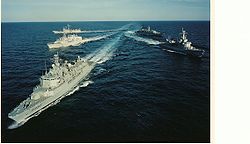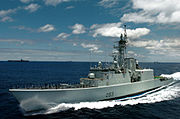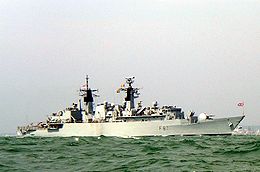- Operation Sharp Guard
-
Operation Sharp Guard Part of NATO intervention in Bosnia 
NATO ships enforcing the blockadeObjective Blockade Yugoslavia Date June 15, 1993 - October 2, 1996 Executed by  NATOMaritime Monitor – Sky Monitor – Maritime Guard – Deny Flight – Sharp Guard – Deliberate Force – IFOR – SFOR
NATOMaritime Monitor – Sky Monitor – Maritime Guard – Deny Flight – Sharp Guard – Deliberate Force – IFOR – SFOROperation Sharp Guard was a multi-year joint naval blockade in the Adriatic Sea by NATO and the Western European Union on shipments to the former Yugoslavia.[1][2][3][4] Warships and maritime patrol aircraft from 14 countries were involved in searching for and stopping blockade runners.
The operation began on June 15, 1993. It was suspended on June 19, 1996, and was terminated on October 2, 1996.
Contents
Background
The operation replaced naval blockades Operation Maritime Guard (of NATO; begun by the U.S. in November 1992) and Sharp Fence (of the WEU).[5] It put them under a single chain of command and control (the "Adriatic Military Committee", over which the NATO and WEU Councils exerted joint control), to address what their respective Councils viewed as wasteful duplication of effort.[1][2][6][7] Some maintain that despite the nominal official joint command and control of the operation, in reality it was NATO staff that ran the operation.[8][9]
Purpose
The operation's purpose was, through a blockade on shipments to the former Yugoslavia,[10] to enforce economic sanctions and an arms embargo of weapons and military equipment against the former Federal Republic of Yugoslavia, and rival factions in Croatia and Bosnia.[11][12][13] The Yugoslav Wars were being waged, and the participants hoped to limit the fighting by limiting supplies to it.
Blockade
Fourteen nations contributed ships and patrol aircraft to the operation. At any given time, 22 ships and 8 aircraft were enforcing the blockade, with ships from Standing Naval Force Atlantic and Standing Naval Force Mediterranean establishing a rotating duty.[14] (Belgium, Canada, Denmark, France, Germany, Greece, Italy, the Netherlands, Norway, Portugal, Spain, Turkey, the U.K., and the U.S.),[11] and eight maritime patrol aircraft, were involved in searching for and stopping blockade runners.[2][15][16][17][18][19] Most contributors to the operation supplied one or two ships.[17] The Turkish Navy, for example, participated with frigates, submarines, and tankers.[20][21]
The operational area was divided into a series of "sea boxes", each the responsibility of a single warship.[11] Each boarding team was composed of a "guard team" to board and wrest control of the target ship, and a "search team", to conduct the search.[11]
The ships were authorized to board, inspect, and seize both ships seeking to break the blockade and their cargo.[22] The Combined Task Force 440 was commanded by Admiral Mario Angeli of Italy.[2] It marked the first time since its founding in 1949 that NATO was involved in combat operations.[4]
Lido II Incident
The issue of differing views among nations in the coalition as to the use of force authorized by rules of engagement arose in April 1994.[23] Faced with the Maltese tanker Lido II making its way towards Montenegrin port with 45,000 tons of fuel oil, a U.S. cruiser asked the NATO commander (a British Commodore) for guidance, and received authorization to use "disabling fire" to stop the tanker, if necessary.[23] He received confirmation that he should follow the British Commodore's guidance from his own higher authority.[23] Under U.S. Navy standards, "disabling fire" means firing rounds into the ship's engineering space. The U.S. cruiser was about to pass the order along to the Dutch Kortenaer class frigate HMNLS Van Kinsberger. However, the fact that the Dutch definition of "disabling fire" involves launching rounds into the bridge of the target ship, with an increased risk of loss of life, became important.[23] The ship was eventually stopped on May 1 and boarded by helicopter from HMNLS Van Kinsberger without firing a shot.[23] Three Yugoslav Navy Končar class corvettes challenged the NATO operation and one of them tried to ram the British frigate HMS Chatham as it was assisting Van Kinsberger. The corvettes eventually fled following the reaction of the British warship, supported by Italian Tornado aircraft which scrambled from an airbase at Gioia Del Colle. The Lido II had to undergo repairs before being diverted to Italy, since the crew had sabotaged the ship's engine room. The leaking was contained by an engineer party from HMS Chatham. Seven Yugoslav stowaways were found on board.[24][24][25]
Statistics
The "NATO and WEU forces challenged more than 73,000 ships, boarded and inspected almost 6,000 at sea, and diverted 1,500 suspect ships to ports for further inspection."[1][2][11] Of those, nearly a dozen vessels were found to be blockade runners, some carrying arms in violation of UN Security Council resolutions.[1][2] NATO officials said no ships were able to run the blockade successfully, and that the maritime blockade had a major effect in preventing escalation of the conflict.[2][26]
Suspension
The blockade was suspended following a UN decision to end the arms embargo, and NATO's Southern Command said that: "NATO and WEU ships will no longer challenge, board or divert ships in the Adriatic".[2] The Independent warned at the time that "In theory, there could now be a massive influx of arms to Bosnia, Croatia and the Federal Republic of Yugoslavia (Serbia and Montenegro), although senior military and diplomatic sources yesterday said that they thought this would be unlikely."[2]
Applicable UN resolutions
The blockade was conducted in accordance with numerous United Nations Security Council Resolutions: UNSCR 713,[27] UNSCR 757,[28] UNSCR 787[29] UNSCR 820,[30] and UNSCR 943.[31] Resolution 787 authorized participating states to "use such measures ... as may be necessary ... to halt all inward and outward maritime shipping ... to insure strict implementation of" the arms embargo and economic sanctions against the former Yugoslavia.[1] Over the course of the operation, the blockade was redefined in accordance with UNSCR 1021[32] and UNSCR 1022.[33]
Ships participating
- FS La Fayette of the French Navy[34]
- HHMS Themistokles of the Hellenic Navy
- FGS Emden of the German Navy
- SPS Asturias of the Spanish Navy
- HMDS Niels Juel of the Royal Danish Navy
- ITS Fenice of the Italian Navy
- FS Jean Bart of the French Navy
- TCG Ege of the Turkish Navy
- HMCS Algonquin of the Canadian Forces Maritime Command[35]
- HMCS Toronto of the Canadian Forces Maritime Command
- ITS Lupo of the Italian Navy
- BNS Wandelaar of the Belgian Navy
- HMS Nottingham of the Royal Navy[2]
- HMS Campbeltown of the Royal Navy[2]
- HNLMS Karel Doorman of the Royal Netherlands Navy[34]
- HMCS Protecteur of the Canadian Forces Maritime Command
- HMS Chatham of the Royal Navy
- ITS Luigi Durand de la Penne of the Italian Navy
- HNLMS Van Kinsbergen of the Royal Netherlands Navy
- HHMS Hydra of the Hellenic Navy
- HMCS Iroquois of the Canadian Forces Maritime Command
- FS Quartier Maitre Anquetil of the French Navy
- FGS Rheinland-Pfalz of the German Navy
- HMS Glasgow of the Royal Navy
- SPS Reina Sofia of the Spanish Navy[34]
- TGC Kocatepe of the Turkish Navy[34]
- ITS Libeccio of the Italian Navy
- RFA Orangeleaf of the Royal Navy
- HNLMS Pieter Florisz of the Royal Netherlands Navy
- HNLMS Jacob van Heemskerk of the Royal Netherlands Navy
- FS Commandant Blaison of the French Navy
- HMCS Huron of the Canadian Forces Maritime Command
- NRP Alvares Cabral of the Portuguese Navy
- SPS Numancia of the Spanish Navy
- ITS Euro of the Italian Navy
- HNLMS Jan van Brakel of the Royal Netherlands Navy
- HMS Battleaxe of the Royal Navy
- HMCS Preserver of the Canadian Forces Maritime Command
- SPS Extremadura of the Spanish Navy
- HHMS Elli of the Hellenic Navy
- USS Bainbridge of the U.S. Navy
- USS Boone of the U.S. Navy
- USS Conolly of the U.S. Navy[36]
- USS Theodore Roosevelt of the U.S. Navy
- USS Dwight D. Eisenhower of the U.S. Navy
- USS Cape St. George of the U.S. Navy
- USS Kidd of the U.S. Navy
- USS Conolly of the U.S. Navy
- USS Deyo of the U.S. Navy
- USS Elrod of the U.S. Navy
- USS America of the U.S. Navy
- USS Anzio of the U.S. Navy
- USS Comte de Grasse of the U.S. Navy
- USS Nassau of the U.S. Navy
- USS Nicholas of the U.S. Navy
- USS Normandy of the U.S. Navy[13]
- USS Samuel B Roberts of the U.S. Navy[34]
- USS John Rodgers of the U.S. Navy
- USS Scott of the U.S. Navy[37]
- USS Simpson of the U.S. Navy
- USS Thorn of the U.S. Navy
- USS Monterrey of the U.S. Navy
- USS Vicksburg of the U.S. Navy
- USS South Carolina of the U.S. Navy
- USS Dale of the U.S. Navy
See also
- Yugoslav Wars
- Legal assessments of the Gaza flotilla raid
References
- ^ a b c d e Bruce A. Elleman, S. C. M. Paine (2007). Naval coalition warfare: from the Napoleonic War to Operation Iraqi Freedom. Routledge. ISBN 0415770823. http://books.google.com/books?id=4ubWqD1XcAQC&pg=PA172&dq=blockade+%22operation+sharp+guard%22&lr=lang_en&as_drrb_is=q&as_minm_is=0&as_miny_is=&as_maxm_is=0&as_maxy_is=&num=100&as_brr=3&ei=z0oNTL6sB43MMomoyesE&cd=1#v=onepage&q=%22operation%20sharp%20guard%22&f=false. Retrieved June 7, 2010.
- ^ a b c d e f g h i j k Christopher Bellamy (June 20, 1996). "Naval blockade lifts in Adriatic". The Independent. http://www.independent.co.uk/news/world/naval-blockade-lifts-in-adriatic-1337903.html. Retrieved June 7, 2010.
- ^ "U.S. Draws Criticism for Drawing out of Bosnia Blockade", NPR, November 13, 1994
- ^ a b Peter L. Hays, Brenda J. Vallance, Alan R. Van Tassel (1997). American Defense Policy. JHU Press. ISBN 0801854733. http://books.google.com/books?id=evo4nKODKDsC&pg=PA533&dq=blockade+%22operation+sharp+guard%22&lr=lang_en&as_drrb_is=q&as_minm_is=0&as_miny_is=&as_maxm_is=0&as_maxy_is=&num=100&as_brr=3&ei=z0oNTL6sB43MMomoyesE&cd=7#v=onepage&q=%22operation%20sharp%20guard%22&f=false. Retrieved June 7, 2010.
- ^ Carla Norrlof (2010). America's Global Advantage: US Hegemony and International Cooperation. Cambridge University Press. ISBN 0521749387. http://books.google.com/books?id=lMfuht7crW4C&pg=PA174&dq=blockade+%22operation+sharp+guard%22&lr=lang_en&as_drrb_is=q&as_minm_is=0&as_miny_is=&as_maxm_is=0&as_maxy_is=&num=100&as_brr=3&ei=z0oNTL6sB43MMomoyesE&cd=11#v=onepage&q=sharp%20guard&f=false. Retrieved June 7, 2010.
- ^ Trevor Findlay (1996). Challenges for the new peacekeepers. Oxford University Press. ISBN 019829199X. http://books.google.com/books?id=-rZZW2xuaysC&pg=PA146&dq=blockade+%22operation+sharp+guard%22&lr=lang_en&as_drrb_is=q&as_minm_is=0&as_miny_is=&as_maxm_is=0&as_maxy_is=&num=100&as_brr=3&ei=z0oNTL6sB43MMomoyesE&cd=8#v=onepage&q=%22operation%20sharp%20guard%22&f=false. Retrieved June 7, 2010.
- ^ Simon Duke (2000). The elusive quest for European security: from EDC to CFSP. Palgrave Macmillan. ISBN 0312224028. http://books.google.com/books?id=djyivTHeZYYC&pg=PA214&dq=blockade+%22operation+sharp+guard%22&lr=lang_en&as_drrb_is=q&as_minm_is=0&as_miny_is=&as_maxm_is=0&as_maxy_is=&num=100&as_brr=3&ei=z0oNTL6sB43MMomoyesE&cd=10#v=onepage&q=%22operation%20sharp%20guard%22&f=false. Retrieved June 7, 2010.
- ^ Giovanna Bono (2003). NATO's 'peace-enforcement' tasks and 'policy communities,' 1990-1999. Ashgate Publishing, Ltd.. ISBN 0754609448. http://books.google.com/books?id=UhT4G7aXK9oC&pg=PA58&dq=blockade+%22operation+sharp+guard%22&lr=lang_en&as_drrb_is=q&as_minm_is=0&as_miny_is=&as_maxm_is=0&as_maxy_is=&num=100&as_brr=3&ei=z0oNTL6sB43MMomoyesE&cd=9#v=onepage&q=%22operation%20sharp%20guard%22&f=false. Retrieved June 7, 2010.
- ^ Volker Rittberger (2001). German foreign policy since unification: theories and case studies. Manchester University Press. ISBN 0719060400. http://books.google.com/books?id=KxuQSfPJeEoC&pg=PA170&dq=%22operation+sharp+guard%22&lr=lang_en&as_drrb_is=q&as_minm_is=0&as_miny_is=&as_maxm_is=0&as_maxy_is=&num=100&as_brr=3&ei=t34OTKSGKYayNs_ovKEI&client=firefox-a&cd=50#v=onepage&q=%22operation%20sharp%20guard%22&f=false. Retrieved June 8, 2010.
- ^ Judy Woodruf (June 2, 2010). "As Flotilla Inquiry Calls Grow Louder, Legality of Gaza Blockade Examined". PBS NewsHour. http://www.pbs.org/newshour/bb/middle_east/jan-june10/gaza2_06-02.html. Retrieved June 7, 2010.
- ^ a b c d e Kathleen M. Reddy, "Operation Sharp Guard: Lesson Learned for the Policymaker and Commander", June 13, 1997, retrieved June 7, 2010
- ^ "Analysis: NATO's predecessor about to go out of business.". United Press International. November 20, 2000. http://www.highbeam.com/doc/1G1-67138475.html?refid=gnews_1108. Retrieved June 7, 2010.
- ^ a b Jack Sweetman (2002). American naval history: an illustrated chronology of the U.S. Navy and Marine Corps, 1775-present. Naval Institute Press. ISBN 1557508674. http://books.google.com/books?id=fAm1Y6gjYtwC&pg=PA292&dq=blockade+%22operation+sharp+guard%22&lr=lang_en&as_drrb_is=q&as_minm_is=0&as_miny_is=&as_maxm_is=0&as_maxy_is=&num=100&as_brr=3&ei=z0oNTL6sB43MMomoyesE&cd=2#v=onepage&q=%22operation%20sharp%20guard%22&f=false. Retrieved June 7, 2010.
- ^ Vaughan Lowe, Adam Roberts, Jennifer Welsh (2008). The United Nations Security Council and war: the evolution of thought and practice since 1945. Oxford University Press US. ISBN 0199533431. http://books.google.com/books?id=5ROlQUFZIpoC&pg=PA216&dq=%22sharp+guard%22+-operation-sharp-guard&lr=lang_en&as_drrb_is=q&as_minm_is=0&as_miny_is=&as_maxm_is=0&as_maxy_is=&num=100&as_brr=3&ei=Zt0OTMvGNpT8zATVk9G-Cg&cd=79#v=onepage&q=%22sharp%20guard%22%20-operation-sharp-guard&f=false. Retrieved June 9, 2010.
- ^ Michael Brzoska, George A. Lopez (2009). Putting teeth in the tiger: improving the effectiveness of arms embargoes. Emerald Group Publishing. ISBN 1848552025. http://books.google.com/books?id=3pQpZm_V3N8C&pg=PA65&dq=%22operation+sharp+guard%22&lr=lang_en&as_drrb_is=q&as_minm_is=0&as_miny_is=&as_maxm_is=0&as_maxy_is=&num=100&as_brr=3&ei=t34OTKSGKYayNs_ovKEI&client=firefox-a&cd=33#v=onepage&q=%22operation%20sharp%20guard%22&f=false. Retrieved June 8, 2010.
- ^ Anja Dalgaard-Nielsen (2006). Germany, pacifism and peace enforcement; Europe in change. Manchester University Press. ISBN 0719072689. http://books.google.com/books?id=YWS92WULujwC&pg=PA55&dq=%22operation+sharp+guard%22&lr=lang_en&as_drrb_is=q&as_minm_is=0&as_miny_is=&as_maxm_is=0&as_maxy_is=&num=100&as_brr=3&ei=t34OTKSGKYayNs_ovKEI&client=firefox-a&cd=4#v=onepage&q=%22operation%20sharp%20guard%22&f=false. Retrieved June 8, 2010.
- ^ a b G. C. de Nooy (1996). The role of European naval forces after the Cold War. Martinus Nijhoff Publishers. ISBN 9041102272. http://books.google.com/books?id=ayXnBkk3UZkC&pg=PA21&dq=blockade+%22operation+sharp+guard%22&lr=lang_en&as_drrb_is=q&as_minm_is=0&as_miny_is=&as_maxm_is=0&as_maxy_is=&num=100&as_brr=3&ei=z0oNTL6sB43MMomoyesE&cd=14#v=onepage&q=%22operation%20sharp%20guard%22&f=false. Retrieved June 7, 2010.
- ^ Ronald M. Williamson (2000). Naval Air Station Jacksonville, Florida, 1940-2000: An Illustrated History. Turner Publishing Company. ISBN 1563117304. http://books.google.com/books?id=Op1Pj0UGIGAC&pg=PA175&dq=blockade+%22operation+sharp+guard%22&lr=lang_en&as_drrb_is=q&as_minm_is=0&as_miny_is=&as_maxm_is=0&as_maxy_is=&num=100&as_brr=3&ei=z0oNTL6sB43MMomoyesE&cd=5#v=onepage&q=%22operation%20sharp%20guard%22&f=false. Retrieved June 7, 2010.
- ^ Bernd Horn (2006). The Canadian way of war: serving the national interest. Dundurn Press Ltd.. ISBN 1550026127. http://books.google.com/books?id=DLYyYUaue8gC&pg=PA315&dq=blockade+%22operation+sharp+guard%22&lr=lang_en&as_drrb_is=q&as_minm_is=0&as_miny_is=&as_maxm_is=0&as_maxy_is=&num=100&as_brr=3&ei=z0oNTL6sB43MMomoyesE&cd=6#v=onepage&q=%22operation%20sharp%20guard%22&f=false. Retrieved June 7, 2010.
- ^ Brad K. Blitz (2006). War and change in the Balkans: nationalism, conflict and cooperation. Cambridge University Press. ISBN 0521677734. http://books.google.com/books?id=Mvjm82mAKfkC&pg=PA191&dq=%22operation+sharp+guard%22&lr=lang_en&as_drrb_is=q&as_minm_is=0&as_miny_is=&as_maxm_is=0&as_maxy_is=&num=100&as_brr=3&ei=t34OTKSGKYayNs_ovKEI&client=firefox-a&cd=65#v=onepage&q=%22operation%20sharp%20guard%22&f=false. Retrieved June 8, 2010.
- ^ Nurşin Ateşoğlu Güney (2007). Contentious issues of security and the future of Turkey. Ashgate Publishing, Ltd.. ISBN 0754649318. http://books.google.com/books?id=ICzcJIzytVIC&pg=PA181&dq=%22operation+sharp+guard%22&lr=lang_en&as_drrb_is=q&as_minm_is=0&as_miny_is=&as_maxm_is=0&as_maxy_is=&num=100&as_brr=3&ei=t34OTKSGKYayNs_ovKEI&client=firefox-a&cd=56#v=onepage&q=%22operation%20sharp%20guard%22&f=false. Retrieved June 8, 2010.
- ^ William J. Durch (1996). UN peacekeeping, American politics, and the uncivil wars of the 1990s. Palgrave Macmillan. ISBN 0312160755. http://books.google.com/books?id=L1i6EyQTTgkC&pg=PA229&dq=%22operation+sharp+guard%22&lr=lang_en&as_drrb_is=q&as_minm_is=0&as_miny_is=&as_maxm_is=0&as_maxy_is=&num=100&as_brr=3&ei=t34OTKSGKYayNs_ovKEI&client=firefox-a&cd=35#v=onepage&q=%22operation%20sharp%20guard%22&f=false. Retrieved June 8, 2010.
- ^ a b c d e Stacey A. Poe, "Rules of Engagement: Complexities of Coalition Interaction in Military Operations Other than War", Faculty of the Nava War College, February 13, 1995
- ^ a b "NATO and WEU ships encounter Yugoslav Navy while preventing violation of UN embargo". Press Release by NATO/WEU force conducting the Operation Sharp Guard in the Adriatic Sea, 1 May 1994. Release 94/13
- ^ McLaughlin, Rob (2009). United Nations Naval Peace Operations in the Territorial Sea. Martinus Nijhoff Publishers, p. 42, note 81. ISBN 9004174796
- ^ Danesh Sarooshi (2000). The United Nations and the development of collective security: the delegation by the UN Security Council of its chapter VII powers. Oxford University Press. ISBN 0198299346. http://books.google.com/books?id=kxExXlBYgcEC&pg=PA267&dq=%22operation+sharp+guard%22&lr=lang_en&as_drrb_is=q&as_minm_is=0&as_miny_is=&as_maxm_is=0&as_maxy_is=&num=100&as_brr=3&ei=t34OTKSGKYayNs_ovKEI&client=firefox-a&cd=9#v=onepage&q=%22operation%20sharp%20guard%22&f=false. Retrieved June 8, 2010.
- ^ "NATO/IFOR: UN Resolution S/RES/713 (1991)". NATO. http://www.nato.int/ifor/un/u910925a.htm. Retrieved June 7, 2010.
- ^ "NATO/IFOR: UN Resolution S/RES/757 (1992)". NATO. http://www.nato.int/ifor/un/u920530a.htm. Retrieved June 7, 2010.
- ^ "NATO/IFOR: UN Resolution S/RES/787 (1992)". NATO. http://www.nato.int/ifor/un/u921116a.htm. Retrieved June 7, 2010.
- ^ "NATO/IFOR: UN Resolution S/RES/820 (1993)". NATO. http://www.nato.int/ifor/un/u930417a.htm. Retrieved June 7, 2010.
- ^ "NATO/IFOR: UN Resolution S/RES/943 (1994)". NATO. September 23, 1994. http://www.nato.int/ifor/un/u940923c.htm. Retrieved June 7, 2010.
- ^ "NATO/IFOR: UN Resolution S/RES/1021 (1995)". NATO. http://www.nato.int/ifor/un/u951122a.htm. Retrieved June 7, 2010.
- ^ "NATO/IFOR: UN Resolution S/RES/1022 (1995)". NATO. http://www.nato.int/ifor/un/u951122b.htm. Retrieved June 7, 2010.
- ^ a b c d e "Factsheets : Operation Sharp Guard". Air Force Historical Studies Office. http://www.afhso.af.mil/topics/factsheets/factsheet.asp?id=15871. Retrieved June 8, 2010.
- ^ Frank Gale (January 4, 2008). "Stephenville native appointed commander of HMCS Calgary". The Western Star. http://www.thewesternstar.com/index.cfm?sid=122137&sc=23. Retrieved June 9, 2010.
- ^ John Pike. "DD 979 Conolly". Globalsecurity.org. http://www.globalsecurity.org/military/agency/navy/dd-979.htm. Retrieved June 9, 2010.
- ^ "Military News", Pittsburgh Post-Gazette, January 6, 1994, retrieved June 8, 2010
External links
- Security Council resolutions
- UN Security Council Official Website, including all resolutions
- NATO Regional HQ Allied Forces Southern Europe Fact Sheet on Operation Sharp Guard[dead link]
- Update on Operation Sharp Guard, December 1995
- General Framework Agreement
- "Evolution of the Conflict", NATO Handbook, December 18, 2002
- "Operation Sharp Guard: the sea embargo of Serbia and Montenegro", Barberan, J. F., Revista de Aeronáutica y Astronáutica, no. 727, pp. 750–57. October 2003
Categories:- Military operations involving NATO
- United Nations operations in the former Yugoslavia
- Blockades involving the United States
- Blockades
- 1993 in Yugoslavia
- 1994 in Yugoslavia
- 1995 in Yugoslavia
- 1996 in Yugoslavia
- 1993 in Europe
- 1994 in Europe
- 1995 in Europe
- 1996 in Europe
Wikimedia Foundation. 2010.



